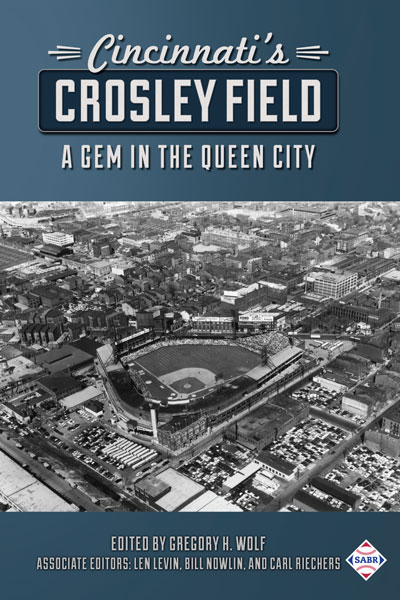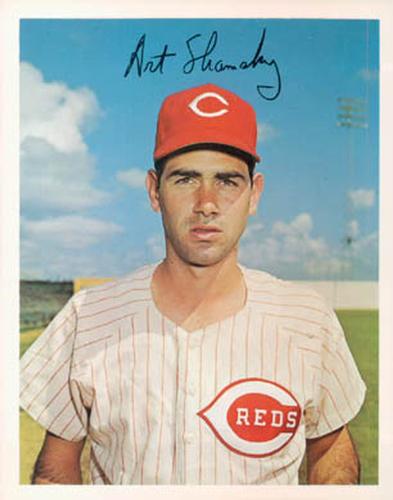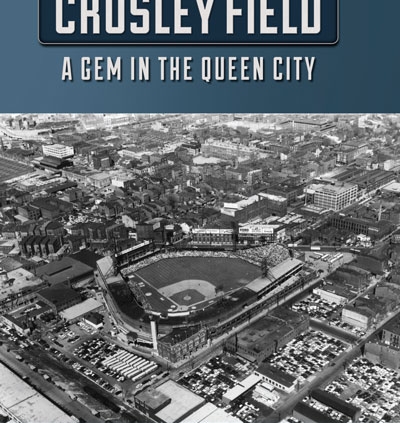Art Shamsky: My Reflections on Crosley Field
This article was written by Art Shamsky
This article was published in Crosley Field essays
Signed by the Cincinnati Reds at the age of 17 in 1959, Art Shamsky debuted in 1965. A back-up corner outfielder during his three years with the club, Shamsky once hit three homers in a game he did not start. He later played for the New York Mets and was an important contributor on their 1969 championship squad, batting .300.
 As early as I can remember growing up in St. Louis, Missouri, my thirst for baseball became the very first thing that I can honestly say actually possessed me. Baseball basically took over my life and I am sure, back then as most youngsters would attest, our dreams were about one day putting on that uniform and playing in the big leagues. I was lucky enough to have a father who also loved baseball, so there were many days when he would take me to Sportsman’s Park, which would later become Busch Stadium, and I would relish the fact that in those moments life was as good as it could be. Later, when I was older and went to the games with friends, the love for those cherished moments never vanished. Heck, I even followed the St. Louis Browns before they moved to Baltimore for the 1954 season.
As early as I can remember growing up in St. Louis, Missouri, my thirst for baseball became the very first thing that I can honestly say actually possessed me. Baseball basically took over my life and I am sure, back then as most youngsters would attest, our dreams were about one day putting on that uniform and playing in the big leagues. I was lucky enough to have a father who also loved baseball, so there were many days when he would take me to Sportsman’s Park, which would later become Busch Stadium, and I would relish the fact that in those moments life was as good as it could be. Later, when I was older and went to the games with friends, the love for those cherished moments never vanished. Heck, I even followed the St. Louis Browns before they moved to Baltimore for the 1954 season.
While those times watching the baseball games in St. Louis remain vivid in my memory, they barely outshadow all the times I glued myself in front of the television or listened to the radio and followed the baseball happenings on that particular day. One of the things that fascinated me was the descriptions and the stories about all of the old ballparks/stadiums that I was lucky enough to follow. Sportsman’s Park, Wrigley Field, the Polo Grounds, Ebbets Field, Connie Mack Stadium, Forbes Field, and Crosley Field were all ballparks that I knew about and, quite honestly, adored. While these were all in the National League, the American League had its own treasures, like Yankee Stadium, Comiskey Park, Fenway Park, Briggs Stadium, Municipal Stadium, and others. All of these treasures are part of the glorious history of the national pastime and are etched in the memories of fans and true life stories of those who actually made their way onto these fields.
As I got older and in my teens and my baseball skills were developing, I realized that my dreams of playing baseball were, in reality, already happening. Not on a professional level but competitively in very good amateur leagues against quality players my age, and that encouraged me to play at my best in order to compete and also forced me to continue to work hard to improve. All this time I was still following the Cardinals and going to big-league games, never losing sight of the importance of history in regard to baseball. And, at the age of 17, while I was playing American Legion baseball, scouts were starting to come around.
 While my beloved Cardinals were interested in signing me to a professional contract along with nine or 10 other teams, I decided to sign with the Cincinnati Reds. I can’t tell you specifically why I chose the Reds. It wasn’t about money. I think it just came down to the way they treated me. They worked me out at Busch Stadium a couple of days when they were in St. Louis to play the Cardinals. What a great experience! Here I was, 17 years old and taking batting practice with Frank Robinson, Vada Pinson, and Jerry Lynch to name a few. What a thrill! And to have Reds manager Fred Hutchinson speak with me and hitting coach Wally Moses talk hitting with me … wow, what else could a 17-year-old ask for? I had played one game at Busch Stadium as a high schooler but those couple of days in a Reds uniform on the same field with the big leaguers was the hook that got me. Plus, I liked the vest uniforms the Reds wore back then. Even with my skinny arms!
While my beloved Cardinals were interested in signing me to a professional contract along with nine or 10 other teams, I decided to sign with the Cincinnati Reds. I can’t tell you specifically why I chose the Reds. It wasn’t about money. I think it just came down to the way they treated me. They worked me out at Busch Stadium a couple of days when they were in St. Louis to play the Cardinals. What a great experience! Here I was, 17 years old and taking batting practice with Frank Robinson, Vada Pinson, and Jerry Lynch to name a few. What a thrill! And to have Reds manager Fred Hutchinson speak with me and hitting coach Wally Moses talk hitting with me … wow, what else could a 17-year-old ask for? I had played one game at Busch Stadium as a high schooler but those couple of days in a Reds uniform on the same field with the big leaguers was the hook that got me. Plus, I liked the vest uniforms the Reds wore back then. Even with my skinny arms!
Up to this point in my life I had strictly been a Cardinals fan. With that being said I loved the game and its history and, of course, its ballparks. Gabe Paul, then the GM of the Reds, signed me that winter (1959) and I went to spring training in Tampa, Florida, in March 1960. It was a world of unknowns to me but I met many interesting characters from all walks of life. None of us in the Reds organization knew how long it would take or how bumpy the road might be or if we would ever make it, but we were all trying to get to the one place that we were all striving for and cherishing. And that was Crosley Field.
My first professional year with the Reds organization in 1960 was in Geneva, New York, in the New York-Penn League. It was that year on that team that I played with Pete Rose and Tony Perez. All three of us would eventually make it to the big leagues, although at that point I’m not sure any of us were considered prospects. Tony didn’t speak much English but we all were able to communicate our desire eventually to get to Crosley Field. All three of us would eventually make it. Pete, of course in 1963. Tony and I a little bit later.
I didn’t know much about Crosley Field’s history when I first started playing there for the Reds in the mid-’60s. I had learned as a kid that Crosley Field was the first ballpark in the major leagues to have lights and that the first game played there under the lights was in 1935. I would come to learn more and more as time went by through basic inquisitiveness. One of the first things that stood out in my mind when I actually went on the field was the terrace in the outfield. I was told it was originally put in so fans could stand on it and be able to be elevated to watch the games. But then, I think, it basically became a warning track for the outfielders. It was around 15 degrees high in left field but not as high as it worked its way over to center and right field. As it turned out, I ended up seeing many outfielders get eaten up as they went back for fly balls. I always felt that if you had one foot on the terrace and one off with your first move going up or down you had a shot to be okay.
Some of my other memories of Crosley Field include seeing the two different signs in the back of the right-field bleachers. One was the Sun Deck for day games and, of course, the Moon Deck for night games. And I’ll never forget the significance of the public-address announcer, Paul Sommerkamp, who was seated on the field near the visiting dugout on the first-base side of the field. I remember he always said your position, your number, your full name, and then just your last name. How special was that?
The quaintness of Crosley Field is so vivid in my mind. Walking to and from the home and visiting clubhouses almost through the crowd in the stands to get on and off the field was special in so many ways. And how can I forget the smell of fresh peanuts being made by the vendors and the smell of recently cut grass on the field and an organist who played his special brand of songs and music. All great memories I have to this day.
Finally, how will I ever forget two of the most significant days in my life and my baseball career that happened at Crosley Field? On August 12, 1966, on a typically hot summer Friday night in Cincinnati, I came into a game against the Pittsburgh Pirates in the eighth inning and proceeded to hit three home runs in a row, two of which were in extra innings. (To this day, I think I am the only player in major-league history to hit three home runs in a game who wasn’t in the starting lineup of that game.) Unfortunately, we lost that game. The next day we were rained out but on Sunday, August 14, 1966 (for some inexplicable reason I didn’t start the game), I was sent up as a pinch-hitter and hit a two-run home run to put us up in the game. It was my fourth home run in a row. Interestingly enough, we lost that game also. Nevertheless, I would be forever remembered for those games and become part of the folklore of Crosley Field. The bat that I used in those two games is on display in Baseball’s Hall of Fame in an area for special feats. To this day I still have people comment about the “four in a row” whether they remember it personally or somehow heard about it. Truly, how can I ever forget Crosley Field?
I have been blessed with so many great memories from baseball. The people I met along the way, players I played with and against, the personal achievements and, of course, being part of a world championship team with the New York Mets in 1969. Even with all that, I would put being part of Crosley Field’s history right at the top of the list.


